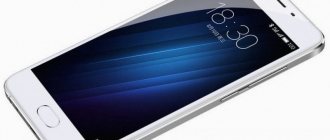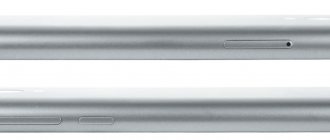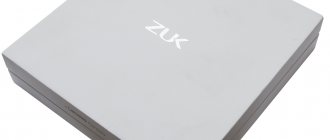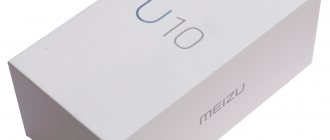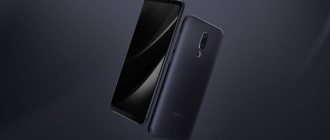The previous flagship line of Meizu smartphones was dedicated to the 15th anniversary of the company and was named accordingly. The company decided to move further from this number, and the new flagships received the number 16: the slightly simpler Meizu 16 and the full-fledged flagship Meizu 16th. Why exactly “sixteenth” is known only to Meizu marketers. But the smartphone is interesting not only by its name: Meizu has once again updated the design of its flagships and finally installed a top-end processor from Qualcomm inside. But the interesting moments do not end there, and we are ready to talk about them in more detail.
Meizu 16th line of Smartphones and mobile phones on
Models in the line: 4
Price range: 7,610 − 9,999 UAH
Contents of delivery
The company did not change the traditional packaging of its flagships. Meizu 16th is packaged in a flat black box without colorful printing - only embossing with the model name and the necessary stickers. In the box: smartphone, USB Type-C cable, power supply, tool for removing the tray, protective bumper made of transparent plastic and documentation.
Design and materials
If you remember the past flagship smartphones of Meizu, you will notice that engineers and designers have no fear of experiments. Either the touch-sensitive LED ring under the screen, which to some extent rose from the dead in the 15th line, or the additional screen on the back. This is good news, and Meizu 16th has also been “refreshed” a little. First of all, this concerns the front panel.
This time there are no physical or touch buttons on the front, as well as a fingerprint scanner - the latter has moved under the display. Thanks to this, it was possible to create minimal gaps at the bottom and top, use the front panel area more efficiently and make the smartphone relatively small with a six-inch display. The display has an 18:9 aspect ratio, rounded corners and does not have a notch, which most manufacturers now use in new models.
The top gap with the camera, sensors, thin speaker slot and LED indicator is only 7 mm wide (according to Meizu). The “chin” visually looks exactly the same. There are no control elements or logo on it. All functional elements are located at the ends of the metal frame; their arrangement is standard. The power and volume buttons are on the right, the tray is on the left. An additional microphone was placed at the top, a speaker, USB Type-C, a conversational microphone and a 3.5 mm headphone jack were placed at the bottom. For those who have not resigned themselves and are not ready to throw away their old, favorite wired headphones or carry an adapter with them.
As you may have already noticed, the smartphone is made of materials typical of a modern flagship model: glass and metal. Meizu 16th is available in traditional black and white colors; there is also a new, “fashionable this season” gradient blue color that smoothly shimmers into green. The rear glass panel has a streamlined sloping shape and smoothly merges into metal ends. The rear layout is similar to the predecessor Meizu 15: a vertical dual camera that protrudes slightly above the body, and a circular six-LED flash with a laser rangefinder built inside. A peculiar “trick” of Meizu flagships for the last few years.
The Meizu 16th looks and feels very nice in the hand and is convenient to use. But the smartphone case does not have dust or moisture protection. However, like most competitors in this price range.
Design, ergonomics
Contrary to the ubiquitous fashion for the ill-fated “bangs,” the new flagship gadget did without this very “hairstyle.” The developers generally emphasize the absence of any clichés and the originality of, on the one hand, the rather uncomplicated, but at the same time elegant, design of the Meizu 16th.
The fact is that the display occupies 91.18% of the entire front surface of the device. In this full-screen solution, the width of the side frames is only 1.43 mm, and only 7 mm were measured at the top and bottom.
The protective glass on both sides “flows” symmetrically around the perimeter onto the matte metal frame of the gadget’s body.
The company itself calls the new mobile gadget the lightest flagship solution of this year, citing the fact that the average weight of competitors is registered in the range of 170-200 g, and the body thickness ranges from 7.6 mm to 8.5 mm. Indeed, a comparison based on such parameters will clearly not be in favor of such a recognized leader as, for example, the 5.8-inch Samsung Galaxy S9: 153 g versus 163 g and 7.3 mm versus 8.5 mm.
The colors chosen for the new product were white, black and blue gradient. But the Meizu 16th’s protection against dust and moisture, alas, has not been certified. The staining of glass surfaces, especially noticeable on black colors, has not gone away. However, the mobile gadget, at least, is not actively trying to slip out of your hands, as some of its classmates do. However, a transparent silicone case was still included in the package.
On the front side, in the protective glass with a 2.5D effect at the top end, an elongated hole was thought out to accommodate the speaker grille, which, together with the multimedia speaker, makes up a stereo pair. There was also room here to accommodate the status indicator (with a blue-white glow), the front camera lens, as well as light and proximity sensors.
See also: Samsung and its sales plans for the Galaxy S8
At the bottom of the screen there was a classic control panel with the traditional “Back”, “Home” and “Recent Applications” buttons, which can be replaced in the settings with one virtual mBack key.
The area of the fingerprint scanner built into the screen is illuminated in Always On Display mode (the display is always on). The sensor itself is based on an optical scanning method similar to those used in the Vivo Nex smartphone.
On the left edge there is a closed slot with a double tray, where there is space for two subscriber identification modules of the nanoSIM format.
Different in length, but equally thin, the volume rocker and the power/lock button are located on the right edge.
The hole for an additional microphone on the top end was shifted to the left edge.
At the bottom end you can see the USB Type-C (USB 2.0) connector, which is surrounded by a decorative grille for a multimedia speaker, which is part of a stereo pair with a speaker, as well as a 3.5 mm audio headset connector and the main microphone.
On the back panel of the gadget, decorated with the Meizu logo, there is a place for vertically located lenses of the rear photo module, which protrude slightly above the surface of the body.
A little lower, in a ring of 6 LEDs, there is a round window for laser autofocus (infrared rangefinder). We have already seen a similar solution, for example, in Meizu Pro 6 and Meizu Pro 6 Plus.
The “high” screen, as always, had a good effect on the ergonomics of the case. In addition, taking into account the capabilities offered in the settings, it is quite possible to control the 6-inch Meizu 16th with one hand. And the gadget lies in the palm of your hand and feels quite confident, especially when it’s already in a clip case.
Display
Meizu loves to use SuperAMOLED displays in its flagship smartphones, and Meizu 16th is no exception. The smartphone has a 6-inch AMOLED screen made by Samsung, this time with an elongated 18:9 aspect ratio, rounded corners and a resolution of 2160x1080. Pixel density is 402 ppi. The manufacturer does not specify what kind of glass is used, but it looks like some fairly budget option: small scratches appear out of the blue. There is a high-quality oleophobic coating, the finger glides perfectly, and fingerprints are removed very easily.
The picture is of high quality and the brightness margin is decent, especially considering the type of display. The viewing angles are maximum, but at some angles the white color may have a slightly green tint, which is also typical of AMOLED. Measurements showed that the maximum brightness is 425 cd/m² - almost the declared 430 cd/m². The color gamut is traditionally wider than sRGB, and color rendition is very good out of the box: there is a minimal deviation towards cool shades:
In “photo” mode the picture as a whole remains similar:
If desired, it is possible to adjust the color rendering. There are 4 preset modes and flexible settings for RGB color components. Also in the settings you can adjust the scale of interface elements, font size and force applications to switch to “full screen” mode.
The AMOLED display made it possible to add Always on Display almost “painlessly” for the battery, and the clock and notifications can be displayed on the switched off screen. There are several options, although there is no such customization as with Samsung smartphones.
Power
If you follow the history of Meizu even a little, you know that the company has consistently chosen Samsung Exynos processors for its top smartphones. There were also models with MediaTek chips, but this time we have the best of the best - Qualcomm Snapdragon 845. For the first time in many years, Meizu has put the most powerful Android on the market in its new smartphone. Happiness? Yeah. The phone comes with 6 or 8 GB of RAM, and it has 64, 128 or 256 GB of its own. The volumes are impressive, in principle, and it’s not scary that there is no memory card, this is not a problem.
We have seen the Flyme 7.1 system before, but we will be glad that Android 8.1 is hidden under it, and not an older version, it’s nice. Although Android 9 is about to appear, when will we have an update there?
I was surprised by the design of the icons in Meizu: the square icons look archaic. The problem can be solved by installing another launcher, but why not immediately do everything beautifully by looking at how MIUI and Xiaomi work?
For more convenient control of your phone, you can use the three classic buttons familiar to Android, and also switch to the gesture system. Which option is closer is up to you to decide; buttons are the easiest, and using gestures allows you to get rid of extra lines on the screen.
In the text I write “flagship”, “top-end” and all that, but you may say: “Oh, what about Meizu 16th Plus”? Yes, there is a version with an even larger screen, but it will not be officially sold in Russia. If you want, order from China yourself, but this is at your own peril and risk, as they say.
Platform and performance
For a long time, Meizu used exclusively MediaTek and Samsung Exynos solutions in its smartphones. Last year, the company established a relationship with Qualcomm and began releasing models with mid-range Snapdragon processors. Meizu 16th became the company's first smartphone based on the flagship solution from Qualcomm: a Snapdragon 845 that needs no introduction is installed inside. This is an eight-core processor with 4 Kryo 385 Gold 2.8 GHz cores, 4x Kryo 385 Silver 1.7 GHz and an Adreno 630 graphics accelerator. The smartphone copes with any modern heavy games, applications, has a power reserve of a year and a half and demonstrates top results in synthetic tests.
Qualcomm's flagship processors heat up noticeably under load; a liquid cooling system with copper tubes is used to remove heat. It copes with the task very well, and with a long maximum load the throttling is 88%.
RAM – 6 or 8 GB, fast LPDDR4X is used, built-in – 64 or 128 GB. The tray only supports the installation of two nanoSIMs; this should be taken into account when choosing the optimal configuration.
Wireless interfaces are represented by dual-band Wi-Fi a/b/g/n/ac 2.4/5 GHz and Bluetooth 5.0 LE. Unfortunately, NFC was not introduced; this is standard practice in China (other tools are used for payment). Meizu promises to install NFC in its smartphones in the future, but not this time. GPS, Glonass and BDS systems are used for navigation.
Performance
Under the hood of the Meizu 16th there is not a simple Snapdragon 845 chip installed, but with bells and whistles: we are talking about a liquid cooling system with copper tubes. It is understood that in games this should provide additional performance by reducing the heating of the device and, accordingly, the load on its “motor”.
And so it turns out: the Meizu 16th is simply gorgeous in games.
First we play PUBG Mobile.
The highest graphics settings are automatically set, and the toy runs smoothly on them, without any brakes or any other problems. For 40 minutes in the game, 12% of the battery charge was consumed - I must say that this indicator is not the best, but we’ll talk about autonomy a little later. And here we just remember that the performance of the smartphone is at the highest level.
Next we launch World Of Tanks.
On the highest graphics with HD textures there are no problems either. The gameplay is smooth, nothing slows you down and doesn’t interfere with destroying enemy equipment. In 35 minutes, 10% of the battery charge was consumed.
Fingerprint scanner and facial recognition
The fingerprint scanner is one of the interesting features of the Meizu 16th: it is located under the screen. The corresponding area to which you need to place your finger is highlighted on the screen. It still looks unusual and, to some extent, futuristic. In fact, it works well, but is slightly inferior in speed to its traditional colleagues.
There is also identification of the owner by face, but it is implemented exclusively using the front camera, without any additional infrared sensors, so it works quickly only in sufficient lighting. Both options are implemented in a simple and clear way, so you won’t get confused.
Hardware
Previously, the Chinese developer Meizu preferred MediaTek processors, occasionally resorting to chips from Qualcomm, but Meizu has never put flagship crystals in its phones. Even the “semi-flagship” Meizu 15 plus is powered by the penultimate Samsung Exynos 8895 processor.
Meizu 16th became the first flagship powered by Qualcomm’s top solution – Snapdragon 845, which had a very good effect on the performance and capabilities of the device. The technical characteristics of the processor have long been known to everyone - it is an 8-core chip with Kryo 385 Gold and Silver computing units, built using a 10-nm process technology and 2-cluster architecture.
Thanks to the fresh chip, the new phone received the latest version of Bluetooth 5.0 with support for aptX and LDAC codecs for transmitting high-quality audio over the air. Plus, it uses an efficient liquid cooling system. That is, the coolant removes heat from the processor through 0.4 mm thick copper tubes, dissipating it through the case, which eliminates strong heating at one point. As a result, there is no throttling when launching “heavy” games, and the game does not freeze or slow down during the entire operating time.
The phone also has 8 GB of LPDDR4X RAM, 256 GB of memory, a 3010 mAh battery (3640 mAh in the Plus version), and supports mCharge technology. The presentation says that in half an hour the phone gets 67% charge, which is not bad.
Sound quality
Previously, Meizu's flagship smartphones were famous for their high-quality sound in headphones - after all, it was not for nothing that the company started with players. At the moment, this criterion is not so critical for the mass buyer, and the smartphone is content with the built-in Qualcomm Aqstic DAC, plus the Cirrus Logic CS35L41 amplifier is mentioned, but it seems that it is used for speakers. The sound in the headphones is very good, in the smartphone category, but Meizu 16th cannot be called “audiophile”. Still, solutions with ESS Saber sound more interesting.
The smartphone produces full stereo sound from the speakers. And it’s worth saying that it’s very powerful and of high quality, so you can play or watch YouTube videos while lying on the couch. The proprietary player has slightly expanded functionality. In addition to standard functions and an equalizer, there is a so-called Square Sound with effects: bass boost, 3D and more.
Interface and software
Meizu 16th is equipped with Flyme 7.1.1.0G based on Android 8.1 Oreo OS. The interface will be familiar to those who have used Meizu smartphones before. The shell does not have a separate application menu, only shortcuts on desktops, everything is significantly redrawn in a flat, minimalistic style. The settings menu and curtain are arranged in the usual way; there is also a simplified mode with large shortcuts.
Innovations affected navigation. Previously, Meizu smartphones relied in this matter on the touch button under the screen, which was also a fingerprint scanner. Meizu 16th does not have it, but there are several navigation options to choose from: for example, you can enable the standard Android navigation bar with separate buttons, but two more options are more interesting. One is a virtual mBack button in the form of a strip with mEngine 2.0 tactile feedback. Tapping it takes you back, tapping it to go to the home screen, and swiping up next to the bar opens the task manager. The third option is full gesture control from the extreme points of the screen. There are also traditional Flyme gestures for launching applications or controlling the player.
The Application Manager looks like vertical or horizontal cards with rounded corners. From the Application Manager, you can launch two-window mode and close or pin the desired applications.
Flyme has always been famous for its abundance of additional proprietary software, and the new version continues this tradition. There's everything from really useful unit converters to not-so-useful virtual coin tosses.
We had a commercial smartphone with a stable global version of the software. In general, everything works quickly, without glitches or any serious bugs. Only a couple of menu items remained in English.
Meizu 16th review: software features
The new flagship runs on the Android 8.1.0 (Oreo) operating system, the interface of which is replaced by the proprietary Flyme 7.1.1.0RU shell. As you know, there is no application menu, and program shortcuts, folders and widgets are placed directly on the desktop. The notification shade has space for quick access to 15 quick settings icons, as well as a brightness adjustment slider. In some situations (for example, in a car), the so-called “Easy mode” with large icons and fonts will be more convenient.
To control your smartphone, you can choose between standard icons on the Android navigation panel (Back, Home, Recent Apps), the mBack virtual button, and gestures.
In the "Special" section capabilities" provided for the activation of the game mode. They also collected gestures for quickly waking up the smartphone, as well as “smart” gestures for an additional “ring” with adjustable transparency.
A running program can be protected from closing, the contents of its screen can be hidden when scrolling, or (if possible) opened in one of two windows into which the screen is divided. In this case, depending on the settings, the list of open applications opens horizontally or vertically.
Although the fingerprint scanner is located under the smartphone screen, it can still store up to five fingerprints and recognize papillary patterns from any angle in 0.25 seconds. At the same time, the accuracy of fingerprint recognition is (according to the manufacturer) above 99%. Using a scanner, you can not only make it difficult for unauthorized access to your smartphone, but also, for example, limit the launch of any application. However, to quickly unlock the device, the facial recognition procedure seemed more convenient. It is worth recalling once again that the listed biometric methods do not provide the proper level of information security.
After connecting to a Wi-Fi network, it is possible to diagnose it, and, in addition, measure the actual exchange speed.
Camera
The main camera of Meizu 16th consists of a 12 MP Sony IMX380 module with f/1.8 aperture, 1.55 micron pixel size and 4-axis optical stabilization, and an additional 20 MP Sony IMX350, f/2.6 and 1.0 micron pixel size. There is background blur and 3x zoom. The proprietary ring flash consists of 6 diodes, in the center of which a laser autofocus is installed. The video is shot in 4K. The interface remains simple and clear. Everything you need is included in one or two clicks, but sometimes not everything goes smoothly with localization. For example, portrait mode in Ukrainian localization was translated as “Book orientation”.
The camera copes well in any shooting conditions and in general is inferior, perhaps, only to the flagships of more popular brands. During the day, photos are rich, with natural color reproduction, excellent dynamic range and very good detail. At night, of course, noise appears, sometimes blur, but in very small quantities.
Battery life
The battery capacity is 3010 mAh, which is quite modest by the standards of modern flagship smartphones. But don’t be afraid that it won’t survive until the evening without refueling: in real conditions, under heavy load with performance tests, games, photos, YouTube and plenty of web surfing, the smartphone survived until the evening without any problems. So one and a half for is not a problem at all. In PCMark Work 2.0 Battery Life, the smartphone lasted 5 hours 27 minutes with maximum screen brightness:
The proprietary mCharge fast charging is supported; the smartphone is fully charged in about an hour and a half. It has its own energy saving modes. For extreme situations, there is a monochrome mode in which almost everything is turned off, including GPS and Bluetooth.
4
ITC.UA rating
Pros: nice design, top-end performance, high-quality display, no notch, high-quality camera, powerful sound in speakers and headphones, futuristic fingerprint scanner
Cons: lack of NFC, MicroSD slot and moisture protection
Conclusion: Meizu 16th turned out to be a full-fledged flagship smartphone with a minimum of compromise solutions. Finally, fans have waited for a Meizu smartphone with the flagship Qualcomm Snapdragon processor and generally top-end performance. “Sixteenth” looks very stylish and interesting thanks to minimal frames, the absence of any cutouts in the screen and the most symmetrical arrangement of all elements. It is compact and easy to use. The screen is bright and of high quality, with a useful addition in the form of Always on Display. The main camera takes excellent pictures and can already compete with more expensive flagships. These advantages of the smartphone are quite enough for the mass buyer to choose. More demanding ones will note the absence of an NFC module, the absence of a MicroSD slot and moisture protection. For some they may become critical. As for competitors, there are plenty of them in the price range of up to 15,500 UAH (that’s how much the top version costs), mostly the flagships of compatriots Xiaomi, OnePlus and Huawei, which also have some not very pleasant features.
Specifications
| Meizu 16th 8/128GB Aurora Blue Notify when on sale | |
| Type | Smartphone |
| Pre-installed OS | Android 8.1 + FlyMe |
| RAM, GB | 8 |
| Built-in memory, GB | 128 |
| Expansion slot | — |
| SIM card type | Nano-SIM |
| Number of SIM cards | 2 |
| CPU | Qualcomm Snapdragon 845 + GPU Adreno 630 |
| Number of Cores | 8 |
| Frequency, GHz | 2,8 |
| Battery | 3010 mAh (non-removable) |
| Diagonal, inches | 6 |
| Permission | 2160×1080 |
| Matrix type | Super AMOLED |
| PPI | 402 |
| Dimming sensor | + |
| Display Features | 430 cd/m?, 2.5D display, Always-On Display |
| Main camera, MP | 12 (f/1.8)+20 (f/2.6) |
| Video shooting | + (2160p 30fps) |
| Flash | + |
| Front camera, MP | 20(f/2.0) |
| Camera Features | 3x optical zoom, laser focusing, optical stabilization, HDR |
| Communication standards | GSM/HSPA+/LTE |
| WiFi | 802.11ac |
| Bluetooth | 5.0 |
| GPS | +(GPS, A-GPS, GLONASS, Galileo, BDS, SBAS, QZSS) |
| IrDA | — |
| FM radio | + |
| Audio jack | + |
| NFC | — |
| Interface connector | USB Type-C |
| Height, mm | 150,5 |
| Width, mm | 73,2 |
| Thickness, mm | 7,3 |
| Weight, g | 152 |
| Protection from dust and moisture | — |
| Type of shell | monoblock (non-separable) |
| Housing material | metal/glass |
| Keyboard type | screen input |
| More | on-screen fingerprint scanner, mCharge 4.0 fast charging |
Meizu 16 smartphone review: not to be confused with Meizu 16th
Table of contents
- Introduction
- Specifications
- Packaging and equipment
- Appearance and design
- Display
- Hardware platform and performance
- Software and firmware
- Safety
- Multimedia
- Wireless Interfaces and Communications
- File system
- Battery life
- Camera
- Comparison with competitors
- Conclusion
Introduction
Most recently, we told readers about the new flagship ]Meizu[/anchor] with the top-end SoC Snapdragon 845, built-in DAC and class-appropriate features.
The device, presented under the name Meizu 16th, received a stylish body and top-end performance. And in a literal translation into Russian, its name sounds like “sixteenth”.
Now we will talk about a smartphone with a very similar name, but belonging to the middle price segment. Before us is a model with a regular digital index, which, according to .
So, what are these features, and how is Meizu 16 able to attract buyers? Let's start traditionally - with the characteristics of the new product.
announcements and advertising
2080 Super Gigabyte Gaming OC for 60 rubles.
Compeo.ru - the right comp store without any tricks
RTX 2060 becomes cheaper before the arrival of 3xxx
Ryzen 4000
series included in computers already in Citylink
The price of MSI RTX 2070 has collapsed after the announcement of RTX 3xxx
Core i9 10 series is half the price of the same 9 series
The price of memory has been halved in Regard - it’s more expensive everywhere
Meizu 16 review: technical specifications
| Device type | Smartphone |
| Model | Meizu 16 |
| CPU | Qualcomm Snapdragon 710 |
| Video processor | Adreno 616 |
| Memory, GB | Operational: 6; Main: 64/128 |
| Screen | 6.0″ SuperAMOLED, 2160 x 1080 |
| Cameras, Mpix | Front: 20; Main: 12 + 20 |
| MicroSD support | No |
| NFC | No |
| GPS/aGPS/GLONASS | Yes Yes Yes |
| Battery, mAh | 3 100 |
| Dimensions, mm | 151.0 x 73.5 x 7.5 |
| Weight, g | 155 |
| price, rub. | 29 990/31 990 (32 990/34 990)* |
*Pre-order price with appropriate memory capacity, expected retail price in parentheses.
The hero of the review does not lay claim to the flagship laurels (unlike the Meizu 16th with Snapdragon 845 and Adreno 630), but can boast of a modern hardware platform and substantial amounts of memory. The display characteristics are the same as the top model, and the camera resolution is quite high.
Meizu 16 review: packaging and accessories
The packaging design repeats that of Meizu 16th - a black flat bar. The material used is thick cardboard. The design is also typical - the lid covers the main box at the top and ends.
The entire front side is decorated with a large digital index. On the reverse side there is identification information of a specific instance and the logo of the processor manufacturer - Qualcomm.
Inside is the smartphone itself and the basic package. No additional accessories are provided.
The package includes:
- Power adapter;
- USB Type C cable;
- A paperclip key for removing the SIM card slot;
- Documentation.
Without standing out as anything special, the packaging looks stylish and expensive. But the most important thing is that the box properly performs its main task of preserving the contents during transportation. But the lack of even a protective cover was a little disappointing.
Meizu 16 review: appearance and design
The smartphone has a typical candy bar design with a touch screen. But with case materials it’s not so simple. Meizu 16 is available in black, blue and white colors. In the case of the first two options, the body will be made of painted metal. Everything is typical here. But the white color is a metal case covered with a layer of ceramics.
This gives the case an attractive appearance and makes it stand out among other devices. According to the manufacturer, the coating is very resistant to any mechanical damage and will resist the appearance of traces of use. Although, of course, you can damage anything if you want.
The front side is covered with protective glass with a good oleophobic coating. The frame around the display in our case is white. In other cases it will be black. The thickness of the frames is similar to the flagship 16th.
Having abandoned the use of a “monobrow” at the top of the display, the manufacturer tried to minimize the frame itself. And it really turned out to be compact.
The ends are a constructive continuation of the back cover. They are rounded and provide a comfortable grip.
From above you can only see the microphone of the noise reduction system. But the bottom end has USB Type C and AUX ports, as well as the main speaker with a conversational microphone.
The configuration of the side faces is standard for most smartphones. On the right are mechanical power and volume control keys, and on the left is a SIM card slot.
The back cover is absolutely smooth with a slight rounding of the entire plane. As mentioned above, in white the lid is covered with ceramics. The surface is glossy. It is not immediately possible to identify the material, but it is clear that this is not ordinary glass. Although fingerprints are collected, they remain invisible.
At the top there is a dual camera, and just below there is an infrared autofocus window and a ring LED flash. The camera rises slightly above the general level of the lid and is protected by a metal rim around the perimeter.
The manufacturer calls the design of the new product laconic, minimalistic and stylish. And we agree with this statement - this is really about Meizu 16. It is well built and looks elegant, although there are no outstanding or memorable features.
The company's corporate style is clearly visible (smartphones of 2014-15 were designed in a similar way), except that despite the external similarity, the quality of materials has increased noticeably.
Meizu 16 review: display test
A lot can be said about the display, but the main thing is that we have already seen this module in Meizu 16th. This is a SuperAMOLED matrix from Samsung. The diagonal is 6.0 inches with a resolution of 2160 x 1080 pixels. The 18:9 aspect ratio is already becoming a classic. The pixel density is 403 ppi.
The viewing angles are wide; when deviated, there are no changes in contrast or color rendition.
White color looks natural, without noticeable deviations in color temperature. But you can see stripes, but you shouldn’t be afraid of them - this is a PWM effect caught by the camera. In practice, no flickering is noticeable.
We tested the backlight brightness in various modes and tested the quality of the factory color calibration.
| Brightness level, % | White brightness, cd/m2 | Black brightness, cd/m2 | Contrast, x:1 |
| 100 | 397 | 0 | ∞ |
| 75 | 291 | 0 | ∞ |
| 50 | 192 | 0 | ∞ |
| 25 | 95 | 0 | ∞ |
| 0 | 1.5 | 0 | ∞ |
The backlight brightness range is quite wide; together with good light filters, the display is easily readable even in sunny weather.
The curves practically coincided with the reference indicators. Although deviations are present, they will not affect the overall impression of the display.
The graphs showed fairly stable results and were located at an equal distance from each other. The result is also positive.
The color temperature level is a little high. The deviation towards cool shades is slightly more than 1000 K. This is a standard situation for the vast majority of modern smartphones.
The color range is noticeably wider than the generally accepted RGB triangle, with a bias towards green shades. This result is typical for this type of matrix.
In accordance with personal preferences, you can select one of several display modes or adjust the color temperature values.
The screensaver when the display is turned off is one of the features that this type of display is loved for. This function is also implemented here. The “Always on screen” item is dedicated to the settings of this mode.
Meizu smartphones often delight us with the use of high-quality displays, and our today's hero was no exception. Having received a matrix similar to the flagship, it received all its strengths. Having worked well on adjusting the color rendering, we managed to achieve a comfortable and pleasant display of colors. At the same time, the manufacturer did not thoughtlessly increase the resolution, as this would lead to an increase in energy consumption.
Meizu 16 review: hardware platform and performance
Meizu 16 is built on the basis of a modern mid-level processor – Qualcomm Snapdragon 710. This chip is made using a 10 nm process technology and is capable of operating at frequencies up to 2.2 GHz. To optimize the balance between performance and autonomy, redistributing tasks and ensuring maximum efficiency, the Qualcomm Hexagon 685 DSP AIE intelligent chip is used - artificial intelligence is used not only in cameras.
We already got acquainted with this processor as part of a recent review of the OPPO RX17 Pro. Then it seemed to us a well-balanced solution, providing good performance with minimal power consumption. Let's see how he performs now.
By the way, unlike the flagship Meizu 16th, the amount of RAM here has no alternatives - 6 GB in any modification.
As when testing the OPPO RX17 Pro, the CPU-Z application does not quite correctly detect the new processor. But the model of the video adapter is indicated exactly - Adreno 616.
Using synthetic benchmark tests, we will evaluate the performance of our hero.
Overall, the results are almost identical to those of the OPPO RX17 Pro. This statement is also true when it comes to subjective impressions of performance in games and other resource-intensive applications.
What can we say about stability and tendency to heat up? Load stress tests helped to understand this issue.
As you can see, the temperature indicators remain within comfortable limits, heating is minimal. Tactilely, the body only becomes warm without causing discomfort. We also note the smartphone’s desire to maintain temperature conditions by throttling the processor. Although the frequency reduction is present, it is short-lived and does not have a noticeable effect on the overall performance of the smartphone.
Meizu 16 review: software and firmware
Meizu 16 runs on the Flyme OS shell, built on the Android 8.1 operating system.
Over-the-air software update function is supported.
Our readers are very familiar with the Flyme OS interface; it is a well-designed and pleasant-looking interface with all the necessary functions.
The settings menu is grouped by topic; you can use the search to quickly find the required parameter.
You can choose one of three control methods - standard buttons, the proprietary mBack button, or gestures.
You can also activate a floating button that can perform a range of functions and commands.
A corresponding mode is provided for control when the display is switched off. By default this feature is disabled.
In accordance with modern trends, the developers have provided a game mode. In this case, it only disables external notifications and optimizes the smartphone for the best performance in games.
The Tools app allows you to turn your smartphone into a measuring tool. No one guarantees the accuracy of measurements, but for basic tasks this may be sufficient.
In general, the interface pleases with its balance, pleasant interface design and customization options. There is no endless list of adjustable parameters, which are easy to get confused. However, all the necessary parameters are present. Moreover, many settings are also provided with convenient explanations and tips.
Meizu 16 review: security
The fingerprint scanner is located under the display - similar to the 16th model. The scanner controls are absolutely standard.
The scanner can be used to unlock the smartphone itself or protected applications and files.
The speed and responsiveness of the sensor is absolutely similar to the older model. The touch is recognized quickly and accurately. Scanner activity is indicated by a corresponding icon in the fingerprint reading area. In standby mode, the scanner is activated if you pick up the smartphone or simply move it from its place. In the rest position, the scanner is deactivated to reduce power consumption.
For those who like maximum comfort and minimum movement, you can use the facial recognition system. However, it is worth remembering that the reliability of such protection is lower than when using a fingerprint or password.
The functionality of this system is similar to a fingerprint scanner.
The function does not have additional infrared sensors and works using the front camera. The response speed is comfortable for everyday use, although in the dark there may be moments of “thoughtfulness” of the system.
Additional data protection is achieved through the use of different operating modes. Thus, to safely transfer a smartphone to a stranger, you can activate guest mode with limited access to personal data. Also in this mode, you can set a ban on making calls and sending SMS.
The second mode is personal. It has the opposite purpose. Here you can store personal data without displaying it in standard mode. This option may be useful when working with confidential data.
If you just need to protect personal files from public access, protected storage in the file manager will help. This directory can only be accessed in the standard file manager by entering a password, scanning a fingerprint or using the facial recognition function - depending on the specific settings.
Meizu engineers have worked hard on the issue of protecting personal files and protecting the smartphone from outside interference. The user is presented with a choice between different unlocking methods, as well as several operating modes of the smartphone with different file access functions.
Meizu 16 review: multimedia
How “omnivorous” is our hero regarding various video formats? Let's look at the testing results of Antutu Video Tester.
As you can see, there will be no difficulties in playing all popular formats.
Applications for playing video and music remain standard for Meizu smartphones. The applications have a convenient and intuitive interface.
For everyday use, the functionality of standard applications will be quite sufficient. If you need more, you can always install a third-party application from the Play Market.
We tested the sound quality of the headphones using an external sound card ASUS Xonar U7 with a recording signal-to-noise ratio of 113 dB. The signal level during calibration was -1.7 dB.
| Parameter | Result | Grade | Schedule |
| Frequency response unevenness (in the range 40 Hz - 15 kHz), dB | +0.05, -0.01 | Great | |
| Noise level, dB (A) | -91.7 | Very good | |
| Dynamic range, dB (A) | 91.5 | Very good | |
| Harmonic distortion, % | 0.0017 | Great | |
| Harmonic distortion + noise, dB(A) | -84.5 | Fine | |
| Intermodulation distortion + noise, % | 0.0079 | Great | |
| Interpenetration of channels, dB | -91.9 | Great | |
| Intermodulation at 10 kHz, % | 0.0095 | Very good | |
| Overall rating | Very good |
For the highest quality sound, the manufacturer has provided a special sound enhancement system called Square Sound. This system is positioned as a joint development with “the best acoustics specialists.” True, who received such an assessment is not specified.
The user can also independently adjust the equalizer settings; the function only works when headphones are connected.
Meizu smartphones have always been positioned as multimedia, with increased attention to the sound component. This issue has also not been ignored here. The sound quality was excellent, providing a good frequency range and a solid volume headroom. A rare user will be dissatisfied with the sound of the Meizu 16. Moreover, to identify shortcomings, you will also need headphones of the appropriate level.
Meizu 16 review: wireless interfaces and communications
Wi-Fi is supported in the 2.4 and 5 GHz bands with a/b/g/n/ac protocols. Bluetooth 5.0 BLE is also present.
Our hero is able to work simultaneously with two Nano-SIMs. They are installed in a common slot.
Management of SIM cards is implemented as standard for the FlymeOS shell.
The transmission speed in mobile networks is not record-breaking, but sufficient for comfortable use. In the conditions of Moscow and the surrounding Moscow region, there were no problems with the stability of mobile communications.
Navigation testing was carried out in position determination mode using all sources. Supports work with all modern navigation systems.
The cold start took about five seconds. Further, the list of detected and connected satellites gradually increased. There were no complaints about the navigation performance - the location is determined accurately and updated promptly.
Meizu 16 review: file system
The capacity of the built-in memory is 64 or 128 GB. We received the older modification for testing. Installing a memory card is not supported - you should decide in advance on the required amount of memory.
The speed of the file system was determined using the AndroBench application.
The results are high enough not to cause discomfort to the user and to ensure the required performance of applications.
The pre-installed file manager is standard for all FlymeOS-based smartphones. Here we can note a well-designed and thoughtful interface, the presence of all the necessary functions.
In general, a rare user will need to look for a replacement for this application due to insufficient functionality. Here you also have access to the secure file storage that we mentioned earlier.
Meizu 16 review: battery life
The manufacturer highlights battery life as one of the strengths of the new product. Preliminary impressions allow us to expect really good performance in this matter. It uses a modern processor with efficient energy-saving systems, the display is made using SuperAMOLED technology, and the battery capacity is 3,100 mAh.
First, let's look at the results of synthetic autonomy tests.
And such results were achieved during testing in our laboratory.
| Scenario | Result |
| Web surfing | ~8.5 hours |
| Playing music | More than a day |
| Playing video | ~9.5 hours |
| Maximum load | ~4 hours |
The discharge graph repeats the performance of Meizu Note 8, which we talked about earlier. The battery discharges evenly, and when the remaining charge reaches 10 percent, a power saving mode is activated, which reduces the processor's performance and allows you to hold out a little longer until it completely shuts down.
To monitor the battery status and manage energy saving modes, there is a corresponding section in the settings.
The included power adapter is standard for all Meizu smartphones equipped with fast charging.
The manufacturer has done a good job of reducing energy consumption and these efforts have borne fruit. The smartphone has a good supply of energy, and the modern hardware platform skillfully distributes this energy for the most efficient use of charge.
Meizu 16 review: camera
The flagship Meizu 16th received well-deserved praise for the quality of the resulting images. Our today's hero is equipped with similar camera modules.
The main camera consists of two matrices. The Sony IMX380 sensor with a resolution of 12 megapixels and optical stabilization is complemented by a Sony IMX350 module with a resolution of 20 megapixels. The lens apertures are f/1.8 and f/2.6, respectively. The camera is equipped with laser autofocus and a six-LED ring flash. The front camera is a little simpler. Its resolution is 20 megapixels, the lens aperture is f/2.0. Artificial intelligence technology is used to improve the quality of images.
The camera application remains familiar from other company smartphones. All necessary modes are available on the main screen, and if necessary, you can expand the list of modes.
Let's look at sample photos and evaluate the quality of the cameras.
Meizu 16 camera test
Example of a photo from the front camera:
Examples of pictures from the main camera (street):
Examples of pictures from the main camera (indoors):
Video example:
I was pleasantly pleased with the quality of the cameras. And this is not surprising, because similar modules are used here with the flagship Meizu 16th. And one of the distinctive aspects of this model is the shooting quality. We note the high quality of shooting in low light conditions and the high speed of the cameras in general.
Meizu 16 review: comparison with competitors
Let's see what smartphones the hero of this review will have to compete with in Russian retail. A budget of about 30 thousand rubles allows you to choose from interesting and modern models.
| Model | Meizu 16 | OPPO RX17 Pro | LG V30+ | Honor 10 |
| CPU | Qualcomm Snapdragon 710 | Qualcomm Snapdragon 710 | Qualcomm Snapdraon 835 | HiSilicon Kirin 970 |
| Video processor | Adreno 616 | Adreno 616 | Adreno 540 | Mali-G72 MP12 |
| Memory, GB | Operational: 6; Main: 64/128 | Operational: 6; Main: 128 | Operational: 4; Main: 128 | Operational: 4; Main: 128 |
| Screen | 6.0″ SuperAMOLED, 2160 x 1080 | 6.4″ AMOLED, 2340 x 1080 | 6.0″ OLED, 2880 x 1440 | 5.84″ IPS, 2280 x 1080 |
| Cameras, Mpix | Front: 20; Main: 12 + 20 | Front: 25; Main: 12 + 20 + TOF 3D | Front: 5; Main: 16 + 13 | Front: 24; Main: 16+24 |
| MicroSD support | No | No | Yes | No |
| NFC | No | Yes | Yes | Yes |
| Battery, mAh | 3 100 | 3 700 | 3 300 | 3 400 |
| Dimensions, mm | 151.0 x 73.5 x 7.5 | 157.6 x 74.6 x 7.9 | 151.7 x 75.4 x 7.4 | 149.6 x 71.2 x 7.7 |
| Weight, g | 155 | 183 | 158 | 153 |
| price, rub. | 29 990/31 990 (32 990/34 990)* | ~49 990 | ~35 000 | ~29 990 |
*Pre-order price with appropriate memory capacity, expected retail price in parentheses.
The first competitor appeared on our list due to the use of a similar platform. This is a new product that will appear in retail sales very soon - OPPO RX17 Pro.
Here the manufacturer paid a lot of attention to the camera's capabilities and achieved good results. Among the advantages, we note the presence of an NFC antenna, high charging speed and good battery life. True, these advantages fade when looking at the price tag. It seems the new product has been overrated. However, these conclusions should be made solely by the user.
Focusing on the cost and capabilities of the camera, we can recall the flagship LG V30+. This is not a new product, but the model cannot yet be called outdated. The manufacturer has equipped the flagship gadget well, and it has not yet lost its relevance, but the cost has noticeably decreased compared to the starting price.
The user is offered a flagship processor of the previous generation, a higher display resolution and an advanced main camera. With a large supply of main memory, the amount of RAM does not seem at all amazing. But this model is equipped with moisture protection according to the IP-68 standard. The biggest questions are raised by the front camera, which has modest characteristics compared to the new Meizu product.
The last competitor is valued by users precisely for its shooting quality. Honor 10 is available in Russian retail at a price comparable to the cost of the review hero for pre-order.
Traditionally, the brand’s smartphones use Huawei’s own solution as the SoC. This processor has a performance reserve comparable to last year’s Snapdragon 835. The memory formula is similar to the LG V30+ discussed above.
Among the differences, it is worth noting the smaller display diagonal and high resolution of each camera. And the advantage will be support for contactless payments using an NFC antenna.
Conclusion
The new product turned out to be very interesting and not without distinctive features. The manufacturer has worked hard to produce a high-quality, stylish and laconic case. In the white version, it is covered with ceramics, which adds a premium look.
The decision to use the same display and camera modules as the flagship Meizu 16th model, but limiting ourselves to a mid-level processor, allowed us to offer the market a smartphone in the mid-price range, giving the experience of use at the level of a full-fledged flagship. If you need a device for everyday life, and not performance tests and the latest games, most likely you will not even feel the differences. But you will definitely feel the difference in cost.
Among the strengths of the device, we note the use of a fingerprint scanner under the screen, a modern hardware platform, and a solid level of autonomy. In addition, the new product inherited from the flagship a high-quality display and advanced cameras.
However, it was not without annoying shortcomings. As is already customary for Meizu smartphones, we will lament the lack of an NFC module and hope for speedy progress in this matter.
Pros of Meizu 16:
- High-quality case;
- Modern SoC with low tendency to heat up;
- High-quality display;
- Flagship level cameras;
- Impressive autonomy indicators.
Disadvantages of a smartphone:
- No NFC antenna.
Alexey Pashchuk
We express our gratitude to:
- To the official representative office of Meizu in Russia for providing the Meizu 16 smartphone for testing.

